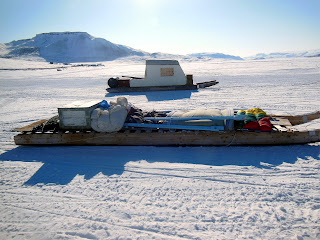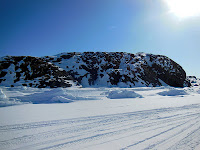Every year, Inuujaq School organizes
a week-long spring camp for all students and teachers. The camp gives everyone the opportunity to
experience living out on the land, and learning traditional Inuit skills, such
as, seal hunting, sewing, preparing country foods, and setting up camp. The planning and preparation of the spring
camp is done by the Spring Camp Committee but the activities are led by local elders
and volunteers. Teachers provide added
supervision. Students must get written
permission from their parents before they can participate in the spring camp.
 |
| David Oyukuluk winding rope. |
This year, the camp ran from May 13
to 17, near Holy Cross Point, some 11 kilometres to the southeast of Arctic
Bay. The location has been used in
previous years because of its close proximity to the community. Rather than travel en masse, classes were
organized into five excursion groups, one for each day of the school week. High school students were first because they
would be setting up the campsite and staying overnight. Tuesday afternoon was reserved for
Kindergarten to Grade 3 classes. Grades
5 to 7 spent all of Wednesday at the spring camp and Grades 7 - 9 had all of
Thursday. Friday was reserved for
Inuujaq School staff meaning students had that day off.
 |
| Arctic Bay Sign |
I was excited about Spring Camp
because I would be spending my first 'night' out on the Arctic land. (I added quotations to the word night because
there would really be 24 hour sunlight).
I assumed the experience would be similar to the weekend Field Training
eXercises (FTXs) I had attended when I was an army cadet down south in Ottawa. The winter FTXs occurred in February and were
staged at CFB Connaught. Just to make
the Spring Camp excursion feel a bit more like cadets, I borrowed two Arctic sleeping
bags from the local 3045 army cadet corps.
This small but smart act saved me from having to buy a new sleeping bag
at the Northern Store.
On the sunny morning of May 13, I
walked to Inuujaq School with my knapsack packed with a change of clothes, a
mug, an extra pair of gloves, ski goggles, and health kit (toothpaste,
toothbrush, deodorant, band-aids, etc.)
Within my large Canada Goose parka, I was carrying: sunglasses, a
digital camera, compass, multi-tool, binoculars, and a small utensil set. To further combat the cold, I was also
wearing snow pants and heavy boots.
Underneath the thick outer layers, I was wearing comfortable civilian
clothing, a far cry from the formal clothing I normally wear to work.
At 9am, high school students and
teachers (Paulette, Iga, and I (Adrian)) headed down to the ice in front of the Northern Store where a convoy
of skidoos and qamutiqs (sleds) would ferry them to the camp site. There was a lot of excitement in the air as
everyone carried their backpacks and sleeping bags down to the ice. Small wooden huts were built onto each
qamutiq to provide shelter for passengers wanting to 'escape' from the cold
Arctic winds. The insides are fitted
with mattresses and curtains to make the ride more comfortable. The huts also allow additional storage space
for supplies, such as, food, fuel, ground sheets, tents, cutlery, and hunting
equipment. After the headcount was
completed, everyone found a seat where they could. This meant jumping onto a qamutiq or riding
on the backseat of a skidoo. The hired
drivers started up their snow machines and began slowly pulling the qamutiqs
that were connected by tough ropes. Once
the entire convoy was in motion, the drivers maintained a steady speed of
25km/h. The camping experience had
begun.
 |
| The cliffs I explored on May 4th. |
The ride in the qamutiq was and is
bumpy. It also can be windy if you
choose not to seek shelter in the qamutiq hut, or if you're riding on a
skidoo. The Inuit didn't look bothered
at all by the cold wind blowing across their faces but for us qaullunaqs, it
was an annoyance. Thankfully, I had my
ski goggles. With my eyes protected from
the cold, I continued snapping pictures of the surrounding landscape. Above me, I was surprised to see a seagull
flying in the clear blue sky. I was
later informed that seagulls do live around Arctic Bay during the summer months
but migrate down south for the winter. About
halfway to the camp site, I was treated to a very wide panoramic view of the
tall red cliffs I explored on May 4th.
It was a little hard to believe that I had walked along the tops of
those cliffs.
 |
| The hill next to Holy Cross Point. |
The convoy turned left and followed
a line of rocky hills after passing the airport. Holy Cross Point came into view on our right
side, marked by a tall wooden stick. The
vast frozen ice suddenly shrunk into a small enclosed inlet as we neared the
camp site. Up ahead, the lead skidoo
drove up onto the flat snow covered ground and stopped. All the other skidoos and qamutiqs stopped
around it. We had arrived at the camp
site.
 |
| Char in a bag. |
As students hopped off the skidoos
and qamutiqs to stretch their legs, I quickly reviewed the photos I took on the
way over. Luckily, very few photos were
blurred. Snow, rocks, and tall jagged mountains
formed the surrounding landscape. The
temperature was around -16ºC. The
students and hired drivers helped the elders unload the tents, ground sheets,
food, and Coleman stoves from the qamutiqs.
While the tents were being pitched, rocks were collected into piles.
The white tents are held up by three
pieces of wood each; two act as posts while the third is a crossbeam. Guy ropes are tied to large rocks for added
stability and to expand the tent's interior space. Like sandbags, smaller rocks are placed
around the tents to prevent the wind from lifting the bottom tent flaps and to
keep the cold out. When all five tents
were pitched, ground sheets and mattresses were placed inside them. Next came sleeping bags, personal belongings,
assigned food rations, and Coleman stoves.
The Coleman stoves serve two purposes: to prepare hot meals &
beverages, and to heat the tents.
Going to the washroom is a bit of a
tricky affair. For men, it's not much of
a hassle because they just can walk several metres and go. Women require more privacy. Since it's not practical to bring an outhouse
on a land trip, one has to be constructed from ice. The women's washroom is basically a half
completed iglu with the top part of the dome missing.
 |
| Leah Kalluk, (wearing green jacket), cuts raw pieces of Arctic Char. |
For lunch, the high school students
ate boiled hot dogs with ketchup and sliced cheese. For drinks, there were juice boxes, hot chocolate, and tea. I ate two hotdogs before being invited to the
elder tent for raw Arctic char.
Naturally, I accepted. The elders
sat around in a circle, cutting up a frozen char with their ulus. They used pieces of cardboard as their
cutting boards. I sat down with them and
ate quite a bit of char, lightly seasoning each piece with salt. While we ate, the elders asked me my age and
if I was enjoying my time in Arctic Bay.
I replied that my time in Arctic Bay had been really exciting. They were surprised when I told them my age because
to them, I look a lot younger. I thanked
them for inviting me and added that the char tasted great.
After lunch, Simeonie Olayuk, an elder and experienced hunter, took the
high school students and I seal hunting.
The small convoy of three skidoos and one qamutiq made their way around
Holy Cross Point before continuing southeast, deeper into the wide frozen
waterway that eventually comes to a stop some 42 kilometres away. (I've been trying to find the name of this
waterway but Google Earth & Maps haven't been helpful. They've only listed this wide body of water
as Northern Passages). Many seals and
their breathing holes can be found in this area. Of course, the ride in the qamutiq was bumpy
but I was beginning to get used to it.
The students told me that that was just part of the experience. What was also part of the experience is
taking in the majestic landscape. All
around us were tall picturesque mountains with snow covered tops. Looking at the summits I now wanted to climb,
I envied the Inuit for having all this land as their backyard.
 |
| Inuujaq School students. |
The seal hunting trip was more of a
stop-and-go affair. We first stopped at
the foot of a mountain with a very steep 90 degree cliff-face. Simeonie climbed up the small rocky hill in
front of it with a telescope to scout for seal holes out on the ice. Rather than wait by the skidoos, several
students and I trekked up the rocky hill to get a better view. We got about halfway up the hill before being
called back down. I quickly took a photo
of the snowy landscape.
Hunters mark seal holes with small
pieces of ice, placing them like small totem poles. When we arrived at the first seal hole, Simeonie measured the thickness of the ice with a long metal rod. Shaking his head, we moved on to the next
seal hole. We were joined by another
group of students at the second seal hole.
Kyle, the Grade 8 & 9 teacher, brought them there in a qamutiq that
he pulled with his powerful Renegade skidoo.
While Simeonie tested the thickness of the ice, everyone waited and
talked. Unfortunately, we had to move
on. This process was repeated two more
times without any luck. It looked like
the seals had retreated deep into the sea beneath the frozen ice.
The convoy suddenly stopped on its
way to the fifth seal hole. Simeonie had
spotted an Arctic hare perched on a hill.
No matter how hard I squinted my eyes, I couldn't see the white hare
against the white snow. Even when one of
my students pointed to it, I still couldn't see it. Simeonie quickly retrieved a rifle with a
telescopic sight and several rounds of ammunition. He loaded one bullet into the chamber and
crouched behind a boulder of ice. Using
the ice to steady the rifle, he looked through the scope and took aim. Everything suddenly became quiet. All eyes were fixed on the hare. I held my breath, waiting for the inevitable
bang.
The elder fired.
To
be continued . . .














No comments:
Post a Comment